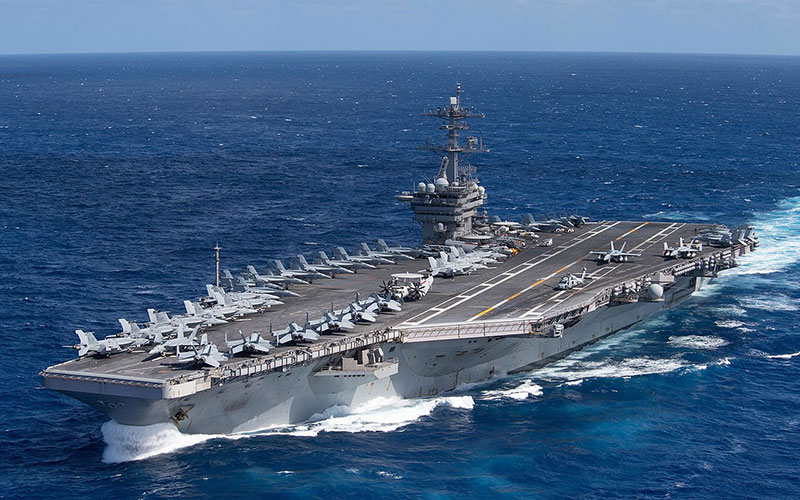Colossal Battle-Ready Naval Power

“The Big Stick,’ USS Theodore Roosevelt.
Following the Palestinian Hamas terrorist group attack on Israel from Gaza on October 7 and the Israeli Defense Force (IDF) response, the international war-tension has begun rising throughout the Mideast. On October 18, Hezbollah strike forces started shelling the small 900-soldier American military base in Syria, and several American bases in Iraq with about 2,500 American military personnel. Hezbollah, a proxy for Iran, was protesting U.S. support for Israel in the Gaza-Israeli conflict. On October 27, the U.S. responded with F-16 and F-15 aircraft strikes against Hezbollah forces in Syria and Iraq. Hezbollah has also been threatening the Golan Heights area of northern Israel with missile attacks. Hezbollah, which is a semi-military Shia Islamic terrorist group sponsored by Iran, is reputed to have 25,000 trained fighters and another 25,000 trained reserves. They may have as many as 145,000 mortars, 65,000 short-range missiles, and 5,000 UAV-drones.
October 23 was the 40th anniversary of the 1983 Lebanese Hezbollah terrorist bombing of a U.S. Marine barracks in Beirut, Lebanon, killing 241 Marines and 56 French military personnel. In March 2011, the Muslim Brotherhood began operations to achieve its long-standing ambition to overthrow the moderate Shia-Alawite Syrian President Bashar al-Assad. The Sunni Muslim “Free Syrian Army” supported by the Obama Administration and Hillary Clinton turned out to be Hamas and al-Qaeda morphing into ISIS. After some al-Qaeda false flags blaming poison gas incidents on the Syrian government in 2017, President Trump made a nominal strike against a Syrian government airfield. By 2019, however, Trump had seen the light and wanted to withdraw all American troops from Syria and Iraq. His military advisers, however, managed to avoid complete withdrawal. The Syrian base was retained because of the value of nearby oil resources.
In September 2015, Bashar al-Assad asked the Russians to assist the Syrian Army in defeating ISIS, al-Qaeda, Hamas, and the other radical Sunni militias. They responded positively and with military assistance from the Turks and support from Iran through Hezbollah regained most of the rebel-held territory within a few years. Some pockets persist, however. The Assad government in Syria is now strongly allied with the Russians.
The USS Aircraft Carrier Gerald R. Ford, CVN 78, was already in the Mediterranean on October 7. It was last anchored off Antalya in SW Turkey. The USS Dwight D. Eisenhower, CVN 66, was ordered to the Mediterranean on October 15 and is now in its western waters.
Just a few days ago, the USS Abraham Lincoln, CVN 72, and the USS Theodore Roosevelt, CVN 71, left San Diego for the Middle East, probably headed to the Gulf of Aden, the Red Sea, the Persian Gulf, or positions off the NE coast of Africa.
According to a retired military staffer to former General and Secretary of State Colin Powell, one aircraft carrier is a warning, three means a serious threat of war. One carrier can keep an enemy busy for 8 hours, three can keep the enemy under attack 24 hours a day. But now four nuclear supercarriers, and not just aircraft carriers, but four carrier strike groups (CSGs) are converging on the Middle East. The U.S. has 11 CSGs, and we are sending four of them to surround and protect Israel. A carrier strike group typically consists of a major nuclear aircraft carrier, one or two guided missile cruisers and a squadron of four to six guided missile destroyers, a nuclear attack submarine, and necessary auxiliary and supporting surface ships. A typical CSG has over 7,500 Naval personnel.
The USS Gerald Ford, CVN 78, the flagship of CSG 12, is the most powerful aircraft carrier in the U.S. Navy and the world. It cost nearly $13 billion. She has a ship crew of 2,600 and an airwing of nearly 2,000 for a total of nearly 4,600. She is 1,092 feet long, 252 feet at the beam, and towers to a height of 250 feet. She requires 37 feet of draft and displaces 100,000 long-tons of water. Yet her top speed is over 30 knots. She has two nuclear reactors and four propeller shafts. She has four missile launching platforms, including surface to air missiles, and 11 defensive guns, cannons, and machine guns, and is packed with radar, electronic warfare, and sensing systems. The USS Ford carries over 75 fixed wing or helicopter aircraft, some with striking range as high as 1,000 miles. Most of the strike aircraft are F/A-18 Super Hornets.
CSG 12 has two guided missile cruisers. One is the USS Normandy, CG-60, which is 567 feet long, 55 feet at the beam, and displaces 9,800 long-tons of water. She has too many types of missiles to name but her armament includes the 75-mile range, sea-skipping .71 Mach Harpoon with a 488 pound warhead. There are also too many guns and machine guns to name. She also has six 12.75-inch torpedo tubes. She carries two helicopters. The crew numbers 330, and the top speed is about 34 knots. The USS Normandy is also loaded with electronic warfare systems, radar, and sensors.
CSG 12 guided missile destroyer squadron probably has six DDGs. One is probably the USS Nitze. The DDG Nitze is 509 feet long and 66 feet at the beam. She has 11 missile launching systems including the Mark 41VLS, which can fire 96 rocket cells vertically in seconds. She has nine gun and machine gun systems, and four torpedo launchers with a variety of torpedo types. Her fully loaded displacement is 9,200 tons, including a sizeable inventory of rockets, missiles, and ammunition. The crew numbers 380. Her speed is 30 knots.
CSG 12 probably has two nuclear attack submarines. They might be of the Virginia Class. The USS Virginia, SSN-774, is 377 feet long and 34 feet at the beam. Submerged speed is 25 knots. She has a crew of 134 and is equipped with four 21-inch torpedo tubes for Mark 48 torpedoes and BGM Tomahawk missiles. She has 11 VLS (vertical launch) tubes. Her tested depth limit is below 800 feet.
Somewhere, already in the Mediterranean, are 2,200 Marines of the 26th Marine Expeditionary Unit aboard three huge LPD ships. LPDs are Amphibious Port Docks. One of these may be the USS Mesa Verde. The Mesa Verde, LPD-19, is 684 feet long and 105 feet at the beam, with a 23-foot draft. She has a crew of 111 and can carry 550 to 700 well-equipped Marines, including armor and artillery. These LPDs usually carry four CH-46 transport helicopters but can also carry Cobra helicopter gunships and vertical takeoff fixed wing attack aircraft. Her listed speed is 22 knots. Her displacement is 24,433 tons fully loaded. She is well armed against attacking aircraft and for close defense and amphibious assault support.
The USS Dwight D. Eisenhower, CVN 66, the flagship for CSG 2, has just reached the Mediterranean. The Eisenhower cost $5.1 billion in 2022 dollars. She has the same length, beam, and draft as the USS Gerald Ford: 1,092, 252, 37, but a slightly larger displacement of 101,600 long-tons. There are over 3,500 in the ship’s crew and 2,400 in the airwing, bringing the total compliment to over 5,900. She carries 90 fixed wing and helicopter aircraft. The principal combat aircraft is the F/A-18 Super Hornet. CSG 2 has two guided missile cruisers (CGs), and six guided missile destroyers (DDGs), and at least one nuclear fast attack submarine. She is loaded with the same electronic warfare, communications, and sensing gear, and defensive weapons as the USS Ford.
The USS Theodore Roosevelt, CVN 71, nick-named “the Big Stick,” is the flagship for CSG 9 and cost $4.5 billion. Its ship crew of 3.200 and airwing of nearly 2,500 bring the total compliment to nearly 5,700. Her dimensions and offensive and defensive weapons are very similar to the Eisenhower, but the Theodore Roosevelt is heavier, displacing 104,600 long-tons. She carries 90 aircraft. The main combat component is the F/A-18 Super Hornet. The Super Hornet has a maximum speed of Mach 1.8 (nearly 1,200 mph) at sea level and can carry a weapons load of nearly 18,000 pounds against distant interception and ground targets. All four carriers converging on the Middle East also have a squadron of the EA-18G Growler electronic warfare version of the F/A-18 Hornet. The “Big Stick” probably has the standard CSG compliment of 9 capital surface warships, a nuclear supercarrier, two guided missile cruisers and 6 guided missile destroyers, plus a nuclear attack submarine, and necessary auxiliary support ships.
“Speak softly and carry a big stick;”—President Teddy Roosevelt, 1901.
The USS Abraham Lincoln, CVN 72, is the flagship for CSG 3. The Lincoln has a displacement 104,300 long-tons and cost $4.7 billion in 2010 dollars. This would be 41 percent higher or $6.6 billion in 2023. The ship’s crew numbers 3,200, and the airwing numbers 2,480 for a total of nearly 5,700. Like the others, she is loaded with electronic warfare, communications, and sensing equipment and defensive missiles and guns. She carries 90 aircraft and like the Ford, Eisenhower and Theodore Roosevelt, she is a Super Hornet nest of formidable strike aircraft. Unlike them, she has a Marine fighter attack squadron of about 16 F-35c Lightning aircraft. CSG 3 probably includes at least one guided missile cruiser, four guided missile destroyers, and a nuclear attack submarine. On 19 August 2021, U.S. Navy Captain Amy Bauernschmidt became the first woman to command an aircraft carrier and a carrier strike group. She was formerly executive officer, second in command, of the Lincoln and is a Naval Academy graduate and former carrier helicopter pilot.
The United States has a colossal and powerfully armed naval armada moving into position to defend Israel. Judging from the heavy emphasis of the legacy media, the Biden Administration, and several hawkish Democrat and Republican senators, their principal potential target is Iran. It is doubtful whether Iran was a major contributor to the October 7 Jihadic Hamas attack on Israel, but Iran continually spews out hatred for the United States and Israel and continually vows to destroy Israel. However, Iran is not the only powerful enemy of Israel in the Mideast and western Asia.
Iran is a nation of 87.6 million people. It is 99.4 percent Muslim, and the great majority of these, 93 percent, are Shia Muslim. More than 85 percent of the Muslim world is Sunni Muslim. Iran’s annual price adjusted (PP) GDP is $1.725 Trillion, the 20th largest in the world. Per capita it is only 80th in the world. Global Firepower (GFP) ranked Iran 17th of 145 nations in military strength in 2023. Israel ranked very close behind at 18th.
Iran’s armed forces are split into two parts. The regular armed forces number about 420,000, while the Islamic Revolutionary Guard Corp (IRGC) has about 190,000 men. This includes their own air force, navy, special forces (Quds), and security forces. The IRGC also controls more than 600,000 highly ideological paramilitary reserves. The Iranian Air Forces total about 50,000 personnel. Combat ready attack and defense aircraft total about 200. Iran’s greatest threat, however, is its missile force. Iran has the largest and most diverse short to midrange missile arsenal in the Mideast. Current maximum effective ranges are 180 to 1,200 miles, and they are working to extend that into the ICBM range of over 1,800 miles. Iran is a major producer of military UAV-drones and is also nearing capability to produce nuclear warheads.
Muslim Brotherhood dominated Turkey is also hurling threats at Israel regarding its threatened invasion of Gaza. Hamas is a Sunni Muslim Brotherhood creation, and Turkey, population 85.3 million, is more than 99 percent Sunni Muslim. Turkey has the largest army in Europe at over one million personnel and can easily raise another 2.0 million. GFP ranks them 11th in world military strength. The small Arab nation of Qatar is literally the financial bank for the Muslim Brotherhood due to its stupendous oil and natural gas resources.
“Pray for the peace of Jerusalem!”—Psalm 122:6.









 Mike Scruggs is the author of two books: The Un-Civil War: Shattering the Historical Myths; and Lessons from the Vietnam War: Truths the Media Never Told You, and over 600 articles on military history, national security, intelligent design, genealogical genetics, immigration, current political affairs, Islam, and the Middle East.
Mike Scruggs is the author of two books: The Un-Civil War: Shattering the Historical Myths; and Lessons from the Vietnam War: Truths the Media Never Told You, and over 600 articles on military history, national security, intelligent design, genealogical genetics, immigration, current political affairs, Islam, and the Middle East. 


